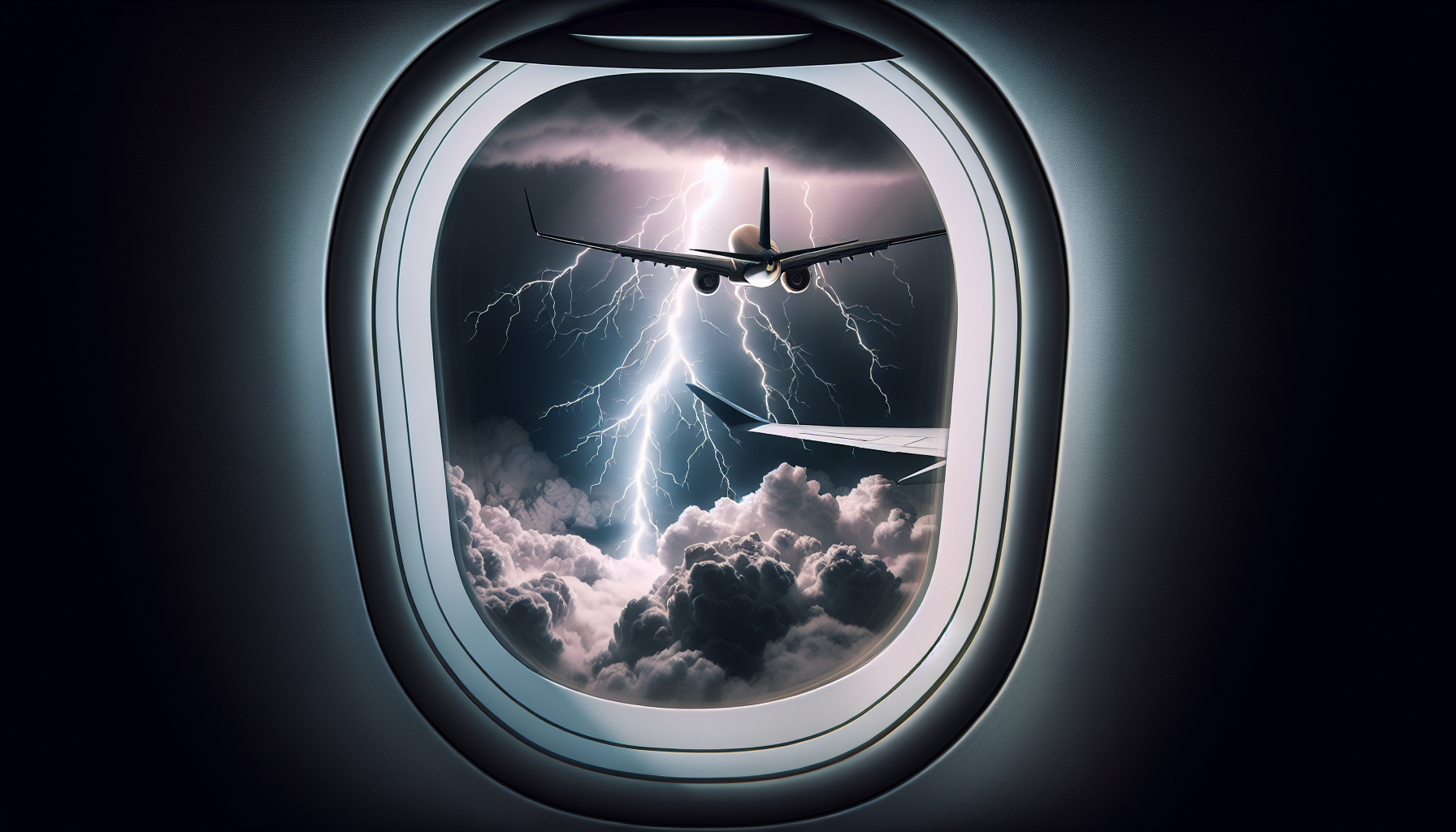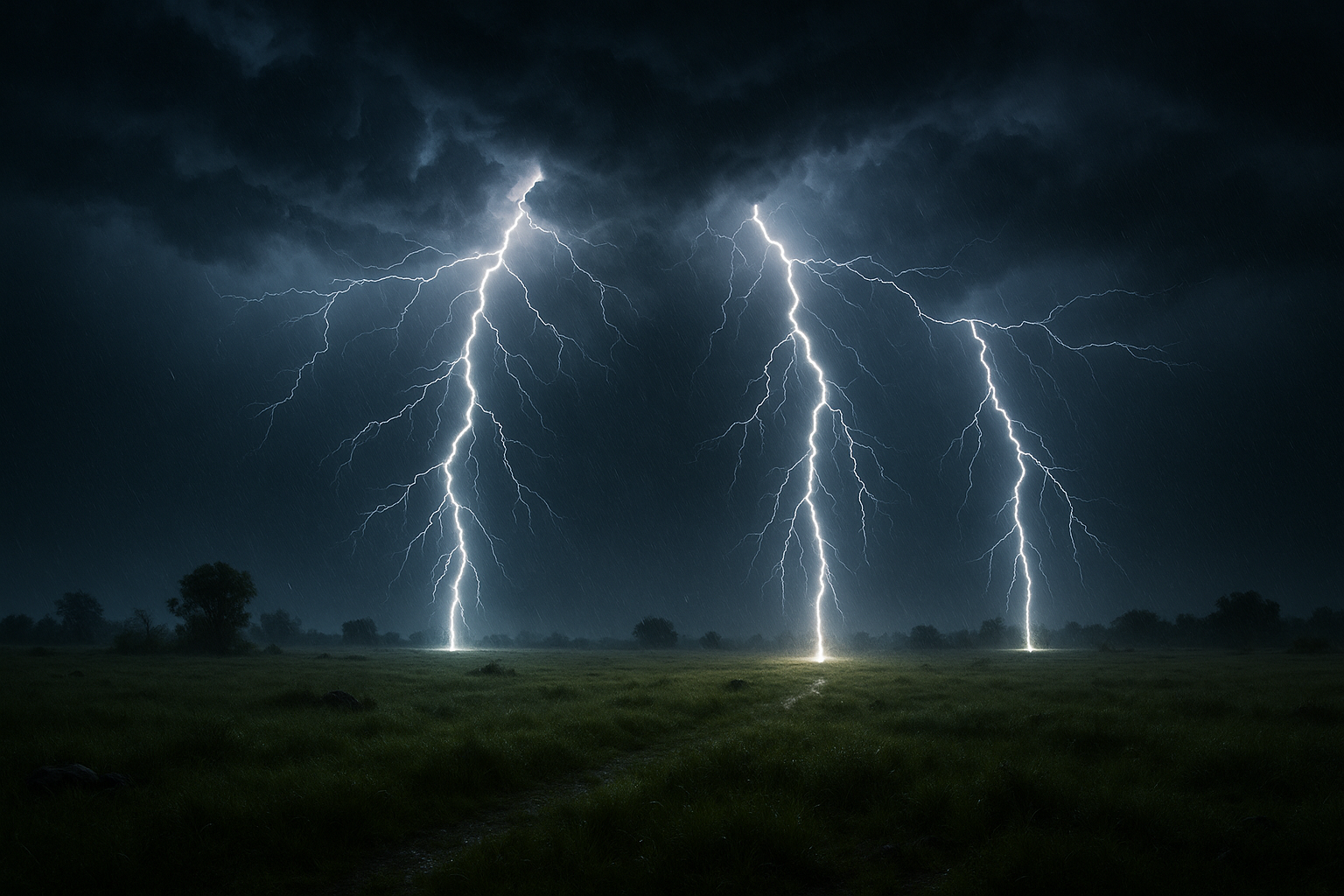Experience the Thrill: Capturing Lightning Strikes from Plane Windows
There’s an unparalleled allure to witnessing nature’s most electrifying spectacle from thousands of feet above the ground. As you settle into your airplane seat, the familiar hum of the engines lulls you into a sense of calm. Yet, as the plane ascends through the clouds, the atmosphere around you transforms into a theater of cosmic drama. Lightning—brilliant, unpredictable, and utterly mesmerizing—illuminates the sky, offering an awe-inspiring performance that captivates even the most seasoned travelers. Capturing these fleeting moments from the small window of a plane is not just a challenge; it’s an exhilarating quest that combines the thrill of adventure with the art of photography. ⚡️
In this article, we delve into the captivating world of aerial lightning photography, where the canvas is the sky, and the brush is your camera. We explore the unique opportunity airplane windows provide to photograph lightning strikes, offering a perspective unlike any other. As you read on, you’ll discover why these aerial vantage points make for perfect observation decks, free from the obstructions and artificial lights that often plague ground-based photography. The vastness of the sky at cruising altitude allows photographers to capture the sheer scale and grandeur of lightning storms, with an unobstructed view that stretches from horizon to horizon.
Our journey will guide you through the essential techniques needed to seize these incredible moments. We will cover everything from the technical aspects of setting up your camera to the timing and patience required to catch the perfect shot. You’ll learn about the importance of shutter speed, ISO settings, and the ideal lens choices to maximize your chances of success. Additionally, we’ll discuss how to anticipate storm activity and position yourself in the airplane for optimal viewing angles. Capturing lightning from an aircraft is no simple feat, but with the right preparation and knowledge, it becomes an achievable—and incredibly rewarding—endeavor.
Beyond the technicalities, we’ll also explore the emotional and philosophical elements of photographing lightning from above the clouds. There’s a profound sense of wonder and connection that comes from witnessing nature’s raw power from such a unique perspective. The unpredictable patterns of lightning serve as a reminder of both the beauty and volatility of the natural world, challenging us to remain both humble and curious. As we conclude, you’ll find yourself not only equipped with the tools to capture these breathtaking moments but also inspired to seek out your own airborne adventures. Whether you’re a professional photographer or an enthusiastic traveler with a smartphone, the experience of photographing lightning from a plane window is an unforgettable journey into the heart of nature’s electrifying spectacle. 🌩️✈️
The Science Behind Lightning: Understanding the Phenomenon
Lightning is one of the most awe-inspiring natural phenomena, captivating humans for centuries. The spectacle of a lightning strike, especially when viewed from a plane window, combines the thrill of flying with the raw power of nature. But what exactly is lightning? Scientifically, lightning is a sudden electrostatic discharge that occurs during a thunderstorm, resulting from the buildup of electrical charges in clouds. This discharge can occur within a cloud, between clouds, or between a cloud and the ground. In the context of aviation, capturing lightning from a plane provides a unique perspective, showcasing the intricate patterns and colors that are often obscured when viewed from the ground.
Lightning formation begins with the separation of positive and negative charges within a storm cloud. As the storm develops, these charges grow stronger until the potential difference between the cloud and the ground, or within the cloud itself, becomes too great to withstand. At this point, the insulating properties of the air break down, resulting in a discharge of electricity. The entire process occurs within milliseconds, but the visual and auditory spectacle can last much longer. When viewed from above, through a plane window, lightning reveals its complex branching patterns and illuminates the cloudscapes in a way that is rarely seen from the ground.
The altitude at which planes fly plays a significant role in the experience of viewing lightning. At cruising altitudes, typically between 30,000 and 40,000 feet, aircraft are often above or within the cloud tops where lightning originates. This vantage point allows passengers and photographers to witness the upper parts of thunderstorms, providing a clear view of the lightning as it dances through the sky. The experience is not only thrilling but also offers valuable insights into the behavior of thunderstorms, contributing to both scientific research and our understanding of meteorological phenomena.
The Risks and Safety Measures for Airplanes
While the prospect of observing lightning from a plane is exhilarating, it raises questions about safety. Fortunately, modern aircraft are designed with numerous safety features to withstand lightning strikes. Airplanes are built with conductive materials and are structured to allow lightning to pass through without causing harm to passengers or critical systems. When lightning strikes an aircraft, the electrical current typically flows along the skin of the plane and exits at another point, usually the tail. This is known as the Faraday cage effect, where the aircraft acts as a shield, protecting its interior from the electric current.
Despite the precautions, pilots and airline operators remain vigilant during thunderstorms. Flight paths are often adjusted to avoid severe weather, and pilots are trained to handle situations where lightning might be encountered. Additionally, advancements in weather radar technology enable better prediction and avoidance of storm systems, enhancing the overall safety of air travel. Passengers can feel reassured knowing that the aviation industry prioritizes safety above all else, even when offering the rare opportunity to capture nature’s light show from above.
To truly appreciate the engineering marvel that allows us to safely observe lightning from a plane, consider the following table, which highlights key safety features incorporated into modern aircraft:
| Feature | Description |
|---|---|
| Conductive Skin | Aircraft surfaces are made of conductive materials to dissipate electrical charges. |
| Lightning Diverters | These are designed to direct electrical currents away from sensitive areas of the aircraft. |
| Faraday Cage Effect | The structure of the plane provides a path for electricity, protecting the interior. |
| Advanced Weather Radar | Modern radar systems help pilots navigate around thunderstorms. |
The Art of Capturing Lightning from Above
Photography enthusiasts and adventurers alike are drawn to the challenge of capturing lightning from a plane. The endeavor requires patience, quick reflexes, and the right equipment. Unlike photographing lightning from the ground, where long exposure times can be employed to capture multiple strikes in one frame, aerial lightning photography demands a more spontaneous approach. The unpredictable nature of thunderstorms and the speed of aircraft require photographers to be ready to capture fleeting moments of brilliance.
Choosing the right camera settings is crucial. A fast shutter speed is essential to freeze the motion of the lightning strike, while a wide aperture can help capture as much light as possible in the often dim conditions of a stormy sky. Stabilization is another challenge, as the plane’s movement can introduce motion blur. Using image stabilization features in cameras or lenses can help mitigate this issue, allowing for sharper images.
In terms of equipment, a DSLR or mirrorless camera with manual settings provides the most control. A wide-angle lens can capture the expansive views outside the plane window, including multiple lightning bolts and the surrounding cloudscapes. For those without professional cameras, modern smartphones with advanced camera capabilities can still capture impressive shots, especially with the use of specific apps designed for low-light photography.
Techniques and Tips for Successful Shots
Maximizing the chances of capturing lightning requires both preparation and adaptability. Here are some tips to consider:
- Research the Flight Path: Choose flights that traverse regions known for thunderstorms to increase the likelihood of encountering lightning.
- Window Seat Advantage: Ensure a window seat for an unobstructed view of the sky and the storm.
- Use Burst Mode: Enable burst mode on your camera or smartphone to capture multiple frames in quick succession, improving the odds of catching a strike.
- Experiment with Settings: Test different ISO settings and exposure times to find the best balance for the lighting conditions.
- Stay Vigilant: Storms are dynamic, so remain attentive and ready to snap a shot at any moment.
For an immersive experience in capturing lightning from a plane, watch this enlightening video: “Capturing Lightning from the Sky” by Aviation Enthusiast.
Lightning Photography as an Artistic Expression
Beyond the technical aspects, capturing lightning from a plane is a form of artistic expression. Each photograph is unique, encapsulating a moment in time that may never be replicated. The combination of natural light, cloud formations, and the vast expanse of the sky provides a canvas for creativity. Photographers can play with composition, using elements like the wing of the plane or the curvature of the Earth to add depth and interest to their images.
Lightning photography also serves as a powerful reminder of the beauty and unpredictability of nature. It allows us to appreciate the transient moments that occur far above our everyday experiences, fostering a deeper connection with the world around us. For many, the pursuit of capturing lightning becomes a lifelong passion, driving them to chase storms and explore new perspectives from different altitudes and locations.
The artistic possibilities are endless, and with each flight, new opportunities arise. Whether the goal is to capture the most dramatic bolt or to explore the subtle interplay of light and shadow in the clouds, the pursuit of lightning photography offers endless rewards.
In summary, experiencing the thrill of capturing lightning from a plane is a blend of science, art, and adventure. It requires an understanding of the meteorological forces at play, the safety measures that protect us, and the techniques that enable us to capture these fleeting moments. For those who dare to look out the window during a storm, the rewards are not only visual but also profoundly inspiring. 🌩️✈️

Conclusion
Experiencing the thrill of capturing lightning strikes from plane windows is a unique and exhilarating endeavor that combines the wonders of nature with the excitement of aviation. Throughout this article, we’ve explored the captivating world of photographing lightning from an aerial perspective, offering insights into the techniques, challenges, and unparalleled beauty that this pursuit entails.
To begin, we delved into the scientific phenomenon of lightning, understanding its formation and the conditions that make it visible from above the clouds. Lightning occurs when there’s a buildup of electrical charges within a storm cloud, and from an airplane window, we can witness this majestic display from a vantage point that few ever experience. This rare perspective allows photographers to capture the raw power and beauty of nature, providing a visual spectacle that is both awe-inspiring and humbling.
We then discussed the technical aspects of photographing lightning from an aircraft. The dynamic environment of an airplane, combined with the unpredictable nature of storms, poses unique challenges. Photographers must be equipped with the right gear—typically a camera with manual settings, a wide-angle lens, and a tripod or stable surface—to increase their chances of capturing a striking image. The use of high ISO settings, fast shutter speeds, and manual focus are essential techniques for obtaining crisp and vibrant photos of lightning in action.
One of the key points addressed was the importance of safety and preparedness. While the allure of capturing such extraordinary images is undeniable, photographers must prioritize their safety and that of their fellow passengers. Understanding airline regulations and being mindful of cabin protocols is essential. Furthermore, knowing the weather patterns and flight paths can help in planning and predicting the best opportunities to capture lightning.
The article also highlighted personal anecdotes and stories from photographers who have successfully captured lightning from plane windows. These narratives not only provided practical insights and tips but also served to inspire and motivate readers to embark on their own photographic adventures. The shared experiences of witnessing nature’s fury from thousands of feet in the air underscore the emotional and aesthetic rewards of this pursuit.
In emphasizing the significance of this theme, it’s important to note that photographing lightning from a plane window is more than just an artistic endeavor; it is a celebration of our planet’s dynamic beauty and a reminder of the intricate forces of nature that surround us. It encourages us to look beyond the ordinary and seek out the extraordinary, finding beauty in unexpected places.
For those intrigued by the idea of capturing lightning strikes from above the clouds, there are numerous resources and communities dedicated to sharing knowledge and experiences. Websites like National Geographic and Photography Life offer valuable tips and inspiring stories from fellow photographers. Engaging with these communities can enhance one’s skills and foster a deeper appreciation for the art of photography.
As we conclude this exploration, we invite you, the reader, to reflect on the incredible interplay between nature and technology that makes such feats possible. Whether you are a seasoned photographer or an enthusiastic traveler, the opportunity to witness and capture lightning from a plane window offers a thrilling adventure that can transform the way you perceive the world.
We encourage you to share your thoughts, experiences, or questions in the comments section below. Have you ever captured a lightning strike from a plane window? What challenges did you face, and what tips would you offer to others eager to try? Your insights could inspire and guide fellow enthusiasts on their journeys.
Finally, we urge you to share this article with friends and fellow photography enthusiasts who might be captivated by the idea of photographing lightning from above the clouds. Together, we can build a community of adventurers and storytellers, each contributing to a collective appreciation of the breathtaking wonders of our world. 🌩️📷
Thank you for joining us on this exploration of capturing lightning strikes from plane windows. We hope it has inspired you to embark on your own adventures and to view the world from new and extraordinary perspectives. Safe travels and happy shooting!
Toni Santos is a visual storyteller and artisan whose creations celebrate the poetry of the natural world. Through his thoughtful artistic lens, Toni captures the elegance of botanical forms, transforming them into meaningful expressions of symbolism, resilience, and timeless beauty.
His journey is deeply rooted in a passion for flora and the mysteries they carry. From the shape of a petal to the curve of a vine, each design Toni brings to life reflects a deeper narrative — one of growth, transformation, and harmony with nature. Whether crafting symbolic floral jewelry, enchanted botanical illustrations, or seasonal visual studies, Toni’s work evokes the quiet magic found in Earth’s most delicate details.
With a background in handcrafted artistry and visual design, Toni blends technique with intention. His creations do more than decorate — they speak, often inspired by ancient meanings behind flowers, the cycles of the seasons, and the invisible bonds between nature and spirit.
As the creative voice behind Vizovex, Toni shares this botanical journey with the world, offering curated stories, handcrafted collections, and thoughtful articles that help others reconnect with nature’s symbolism and artistic essence.
His work is a tribute to:
The quiet power of flowers and their messages
The art of visual symbolism in everyday life
The beauty of slowing down to see what’s hidden in plain sight
Whether you’re an artist, a nature lover, or someone drawn to the deeper meanings behind the natural world, Toni welcomes you to explore a space where aesthetics meet soul — one petal, one story, one creation at a time.





